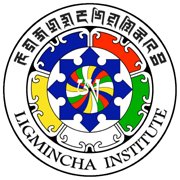
H.H. Lungtok Tenpai Nyima
His Holiness Lungtok Tenpai Nyima, the 33rd Menri Trizin, is the worldwide spiritual leader of the Bon tradition and abbot of Menri Monastery in Dolanji, India. His Holiness was born in 1927 in the village of Kyongstang in the far eastern province of Amdo, Tibet. His mother died when he was quite young, and an elderly friend of the family, A-Nyen Machen, offered to raise him. At age 8 he was brought by his father to a nearby monastery, Phuntsog Dargye Ling, where he began preliminary studies such as reading, writing and chanting. The young monk continued his studies there, and by age 16 entered the monastery's dialectic school. There he engaged in eight years of rigorous training under the guidance of Lopon Tenzin Lodro Gyatso, obtaining his geshe degree in philosophy with a specialty in Tibetan medicine, astronomy and astrology. At age 26 the young geshe traveled to the province of Gyalron, eastern Tibet, where he assumed the task of printing the Bon Kangyur, an important set of sacred texts comprising more than 100 volumes. This printing was accomplished using woodblocks in the possession of the king of Trochen Gyalpo, one of the 18 kingdoms of Gyalrong. His Holiness transported the completed texts by mule in a perilous six-month journey back to Phuntsog Dargy Ling. Soon after his return he made a pilgrimage on foot to China, visiting many holy sites and traveling to Tsang Province in central Tibet. He furthered his studies at the Bon monasteries of Khana, Menri and Yungdrung Ling, where he became known as Sangye Tenzin Jongdong. Life in Exile Sangye Tenzin Jongdong later journeyed by truck to Drepung Monastery in Lhasa, Tibet. He remained there until the violent Lhasa uprising of 1959, when demonstrating Tibetans clashed with occupying Chinese soldiers. At that time the 14th Dalai Lama and some 80,000 refugees, including many Bonpo lamas, were forced to flee across the Himalayas into neighboring countries. Sangye Tenzin Jongdong himself escaped on foot to the district of Mustang, Nepal, and then further into Nepal. He soon joined H.H. Sherab Tenpa Gyaltsen (the abbot of Yungdrung Ling Monastery) and many other Bonpo lamas at the Bon monastery of Samling, a very old and important Bon monastery in Dolpo, Nepal; and in time they all relocated to the valleys of Nepal. In fleeing on foot from Tibet, the Bon lamas had no choice but to leave behind them many precious texts critical to the study and practice of Bon. Many of these texts were later destroyed by the Chinese. Thus, it became critical to the preservation of the Bon tradition to seek out the few remaining texts for republication; these often could be found only in remote areas of the country. His Holiness eventually returned to Samling Monastery to borrow texts for this purpose. There he met David L. Snellgrove, Ph.D., a researcher of Oriental and African studies from London University who was engaged in research at Samling. On Dr. Snellgrove's advice His Holiness and the abbot of Yungdrung Ling traveled to New Delhi to have the monastery's texts reprinted; there His Holiness worked on the project with Samten Gyaltson Karmay and Lopon Tenzin Namdak Rinpoche. In 1962 Dr. Snellgrove invited the three men to join him in England under a grant from of the Rockefeller Foundation. As Dr. Snellgrove's assistants they taught Tibetan culture and religion. Geshe Sangye Tenzin Jong Dong remained in England for three years during which time he also visited and studied at Benedictine, Cistercian and other Christian monasteries. In 1964 he traveled to Rome, where he received a private audience with Pope Paul VI. New Beginnings for Bon Later that year he returned to India, and at the request of His Holiness the 14th Dalai Lama he founded a school in Massori, Northern India, staffed by volunteer teachers from the West and funded by British sponsors. The school was a place for Tibetan refugee boys to receive a high school education. For nearly three years he served as head of the school, each month sending his salary of 300 rupees toward the sustenance of refugee Bonpo monks and lamas living in Manali, India. In 1966 Geshe Sangye Tenzin Jong Dong traveled to Norway at the invitation of Tibetan scholar Per Kvaerne to teach Tibetan history and religion at the University of Oslo. Soon thereafter in 1967, Lopon Tenzin Namdak purchased land in the Himachal Pradesh region of India with help from the Catholic Relief Service in New Delhi, establishing Dolanji as a home for the Tibetan Bonpo refugee community. Becoming Abbot Upon the sudden death of the abbot of Menri, H.H. Sherab Tenpa Gyaltsen (the abbot of Yungdrung Ling, Tibet's second most important monastery) became temporary spiritual head of the Bon tradition in India. H.H. Sherab Tenpa Gyaltsen soon arranged a ceremony in Dolanji to select a permanent successor to the deceased abbot. In Norway on March 15, 1968, Sangye Tenzin Jong Dong received a telegram from India stating that the protectors of Bon had chosen him as the 33rd Menri Trizen: abbot of Menri and spiritual leader of the Bonpos. Under his new name and title, His Holiness Lungtok Tenpai Nyima assumed his duties in Dolanji as the spiritual leader of the Bonpo. His selection came at a very critical time in the long history of the Bon tradition, when the ancient teachings and lineage of teachers came perilously close to being lost for all time. The Bonpo would rely on this new leader to help forge a new beginning in a strange new land. Many lamas arrived from Tibet, Nepal and India to give their initiations and teachings, and for more than a year the new abbot intensively trained and practiced for his role. Slowly over time His Holiness was able to build a new Menri Monastery in Dolanji and subsequently a Bon dialectic school, which would award geshe degrees with certification recognized by H.H. the 14th Dalai Lama. The abbot also founded at the monastery an orphanage for Bon children, known as the Bon Children's Welfare Center. Today Menri Monastery has approximately 100 monks. The Bon Children's Home in Dolanji provides living quarters for 115 children from the Himalayan area, who receive an education consistent with their culture. The Central School for Tibetans at Dolanji educates the children of Dolanji as well as those in the Bon Children's Welfare Center and the Bon Children's Home. A new nunnery, Renla Menling, recently was constructed across the valley from Menri, the first such establishment in India for Bonpo nuns. The town of Dolanji now hosts more than 400 Bonpos and is a center of Tibetan Bon culture and religion. Menri Monastery now serves as the seat for all spiritual and administrative aspects of the Bonpo worldwide. The abbot of Menri, H.H Lungtok Tenpai Nyima, continues to oversee all monastery affairs and serves as the worldwide spiritual leader of Bon. In recent years he has taught frequently at Ligmincha's Serenity Ridge Retreat Center and elsewhere in the West at the invitation of Geshe Tenzin Wangyal Rinpoche and others. The Choosing of an Abbot In the Tibetan Bon tradition, the Menri Trizin is selected by the guardians through a divination process. The 33rd Menri Trizin was chosen in the following way: For each of 10 geshes eligible to become abbot, the lama's name was written on a small piece of paper, and the slip of paper was then enclosed in a small, ceremonial ball of dough made from barley flour and holy medicine. Each dough ball containing a name was then placed in a vase. For 14 days H.H. Sherab Tenpa Gyaltsen, Lopon Sangye Tenzin, Lopon Tenzin Namdak and approximately 10 other Bonpo geshes engaged in prayers and rituals inside the Drup Khang, or protector's temple. At the completion of the prayers and rituals, H.H. Sherab Tenpa Gyaltsen shook the vase and three balls emerged, one by one, to land on a special mandala. The vase was then emptied of the remaining balls, the three balls were replaced, and the process was begun anew. This time just two balls of dough were shaken out, one after the other. Amid initiation and rituals the first ball was opened to reveal the name of Geshe Sangye Tenzin Jong Dong: the one, true abbot of Menri Monastery and new spiritual leader of the Bon tradition. The second person chosen was to be honored with a high position as teacher among the Bonpos. In Norway the night before receiving the telegram, Geshe Sangye Tenzin Jong Dong had a dream that he and the man chosen as his second were together atop a temple, each holding a conch shell sounded as a horn during special moments in ritual. A great windstorm suddenly arose, blew the conch from the hand of the second man, and his conch fell to the ground and broke. Despite the terrible storm Sangye Tenzin Jong Dong was able to maintain a grasp on his conch and sound it.

